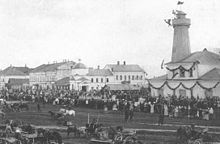- Mologa
-
Coordinates: 58°11.98′N 38°26.47′E / 58.19967°N 38.44117°E
Mologa (Russian: Моло́га) was a town in Yaroslavl Oblast, Russia, formerly situated at the confluence of Mologa and Volga Rivers, but now submerged under the waters of the Rybinsk Reservoir.
Mologa existed at least since the 12th century. It was a part of the Principality of Rostov in the early 13th century. Later on, the town was annexed by the Principality of Yaroslavl. In 1321, it became the center of an independent principality. Soon after that, Ivan III annexed Mologa in favor of the Muscovy. Thereupon Mologa's rulers moved to Moscow, where they have been known as Princes Prozorovsky and Shakhovskoy.
In the late 15th century, they relocated a fair from Kholopiy Gorodok (a town 55 km north of Mologa) to Mologa. After that, Mologa turned into one of the most important Russian trade centers with the Asian countries. According to an account by Sigismund von Herberstein, there was a fortress in Mologa.
 Sennaya Square during the annual fire brigade celebration in Mologa. A fire lookout tower (on the right) was designed by Andrey Dostoyevsky.[1]
Sennaya Square during the annual fire brigade celebration in Mologa. A fire lookout tower (on the right) was designed by Andrey Dostoyevsky.[1]
Following the Time of Troubles, Mologa thrived as a trade sloboda. In the 19th - early 20th centuries, it was a big staging post on the Volga because the town had been located at the beginning of the Tikhvin waterway system, connecting the Volga with the Baltic Sea.
During the construction of the Rybinsk Reservoir and Rybinsk hydroelectric plant, the town of Mologa was evacuated and engulfed by water in the 1940s. Around 130,000 people were forced to move from Mologa and the surrounding areas. 294 locals refused to leave their homes despite NKVD's insistence and eventually drowned.[2]
April 14 is remembered in Yaroslavl Oblast as the Day of Mologa. On this day, the boats with monks and priests sail to the spot where Mologa used to stand, and hold divine service in front of the upper parts of cross-crowned belfries which are still visible above the water of the artificial lake.
See also
- Korcheva
- Flooded Belfry
References
- ^ Potashev, I. "Ярославские зодчие. Андрей Михайлович Достоевский [Yaroslavl architects. Andrei Dostoyevsky]" (in Russian). http://emsu.ru/um/excurs/Yaroslavl/zodchie.htm. Retrieved 20 September 2010.
- ^ Death of Mologa Argumenty Nedeli №19(19) 14 September 2006 (Russian)
External links
- Statistics and history of Mologa (Russian)
- Photos of a dead city by Dmitri Krasavin (Russian)
- Mologa - The Memory and Pain by Dmitri Krasavin (Russian)
- History of Flooding of Mologa (Russian)
Categories:- Ghost towns in Europe
- Sunken cities
- Yaroslavl Oblast
- Defunct towns in Russia
- Former populated places in Russia
Wikimedia Foundation. 2010.


